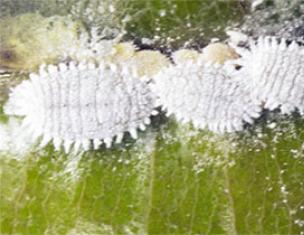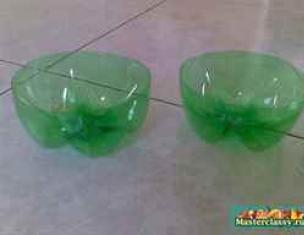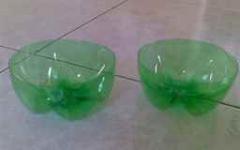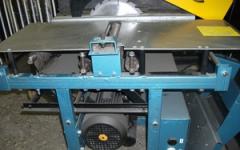With the development of HTML5 and mobile platforms, 2D games are back in vogue and are attracting the attention of even major publishers. With tools like Unity and online game asset resources, developing these games has become a lot easier. Below is a list of the top 10 sites with 2D gaming resources, both paid and free.
*Sites listed in random order*
1. Unity Asset Store (paid)
The largest site with paid game assets. It is not necessary to use the Unity engine for work - in order to access resources on the Asset Store, you just need to download it free version. The downloaded files will be saved to the Unity project folder, from where they can be imported into any 2D game engine.
It is worth noting that Unity in the hands of a skilled developer has a huge potential, as evidenced by the large number of successful 2D games (which is only worth the popular Bad Piggies from Rovio). And the Unity Asset Store offers the widest selection of 2D assets.
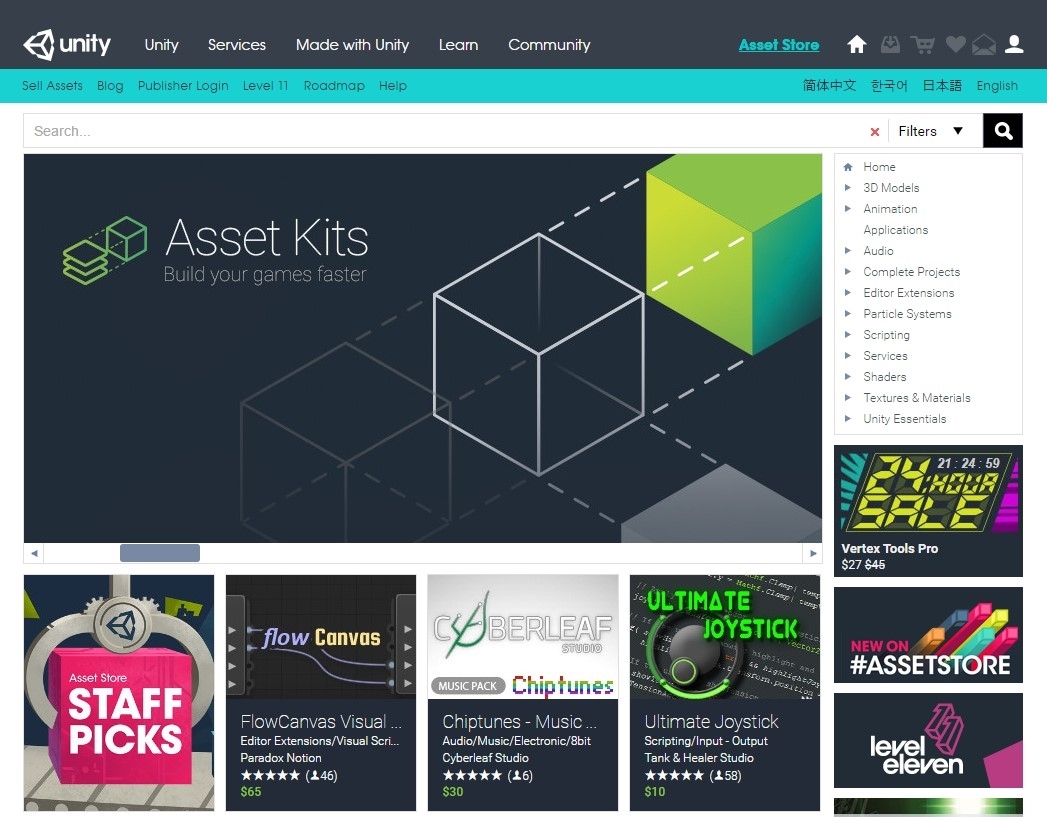
2. GameDev Market (paid)
GameDev Market is a relatively new site, conveniently organized by content categories (similar to Super Game Asset, which will be discussed below). Here you will find both 2D and 3D assets including UI, character sprites, icons and environments. Artists put up assets for sale, and the range is growing every day.

Graphicriver is one of the most popular stock image resources. In connection with the development of casual mobile games, a separate category with 2D assets has appeared there. Before being posted on the site, all content is internally checked, and after publication, any user can leave their rating and feedback. Bottom line: this is a reliable, actively developing site under the close moderation of Envato.

4. Scirra Store (paid)
Scirra is the developer behind Construct 2, a popular HTML5 2D editor that recently launched its own asset store. Here you can find audio, graphic resources, and even ready-made game templates for Construct 2. However, you can use any other 2D editor for work.

5. Game Art Partners (paid)
At Game Art Partners, you can buy a variety of cartoon assets for 2D platformers, including animated characters, monsters, weapons, visual effects, and UI kits.

6. Super Game Asset (paid)
If you are creating an RPG or a game with isometric graphics, this site is for you. Here you will find the highest quality assets: colorful RPG icons (probably the best available online), 2D sprites, animated character sprites and huge isometric maps. Most importantly, most of the resources presented are made in the same style.

7. Open Game Art (Free)
A definitive resource for open source game developers, Open Game Art can be called the largest collection of freely licensed game assets. All materials - from sprites to icons - can be downloaded under GNU or Creative Commons licenses. This is a great site for beginners, but many of the assets differ in visual style, so they will have to be carefully selected.
![]()
8. Kenney Game Assets (Free)
Another great site with over 20K assets including UI elements and various sprites for 2D platformers. Most of the resources are presented in vector graphics and are suitable for any device, regardless of screen resolution. Assets can be downloaded individually (for free) or as a set (for a modest $9 fee).

9. Game-Icons.net (Free)
Game-icons.net is the best site with free icons, there are no less than 2000 of them. Despite the fact that all icons black and white, they are quite versatile and can be used to denote actions, spells, skills, items, etc. A nice bonus is the vector format.

10. Reiner's Tilesets (Free)
The best site with free tiles. Here you can find sprites of animals, plants, buildings, weapons, visual effects and almost any object for RPG with isometric graphics. The style of the assets is reminiscent of Diablo II. This is a great resource for aspiring developers who want to test a game engine or start building their own game.

He is currently the lead artist for the firm's game development department. "1C". Previously worked on a number of console projects for the company Creat Studios.
This article is a summary of the experience of practical work on graphics for game projects and an attempt to understand: what is game graphics and what does it consist of?
Without a good understanding of the essence of this issue, it is difficult to do right choice at different stages of the project, it is difficult to establish communication with game designers and programmers, it is difficult to argue the implementation of a particular solution.
Unfortunately, this article will not address the analysis of performance evaluation. decisions taken and give recipes. Perhaps this will need to be done in future articles, using the example of analyzing decisions in some game titles - this is a separate and large topic.
The general direction of the article is rather theoretical, but for some situations it will be offered practical advice and recommendations.
Game graphics requirements
Graphic game content has several functions: semantic (semantic, clarifying game mechanics) and decorative, complementary, diversifying the game. It also depends on the quality of the graphics, including whether the player will be "immersed" in the atmosphere of the game.
Achieving a result that meets all these requirements is not easy, but there are also time limits, because the creation of game graphics is a serious design task. Resources are needed: a team, a budget, a lot of time and the ability to make smart decisions.
What to focus on when creating such a different and multifunctional material?
Game graphics have many points of contact with different areas of graphic design, but I would like to draw attention to the closeness of game graphics and architecture / environmental design. Process architectural design usually goes in the following direction:
- The study of functional problems of space
- Artistic organization
- Saturation with expressive details
All of this applies to games as well. They are also related by the principle of "anthropomorphism" - the designed elements must be proportionate to a person, ergonomic (doorways, stairs, etc.).
It should immediately be clarified that in games, ergonomics should be convenient for the player, and not for his avatar. Just like architecture, game graphics should follow function - in our case, game design defines game function, so good game graphics are impossible without a good game design document.
The central point for graphics in game projects is the concept of art direction. Usually, this term means the following: the graphics in the game must be original and internally consistent, i.e. the game must have style. To ensure high-quality art direction, it is necessary to carry out a set of measures aimed at producing rich and integral graphic content.
Graphic content production
The creation of game content takes place along the usual chain: preparation (pre-production), production itself, assembly and adjustments. Among these activities, one of the most important phases is pre-production. In itself, the presence of pre-production is a declaration that the task of originality and consistency of graphics is set and will be controlled.
Each project imposes its own limitations: technological, ergonomic, temporary and others. Those are the ones to be found out. The main questions that arise at this stage are what expressive means will convey the general atmosphere of the game, the setting, how the characters will look, the main visual elements (logos and key locations, buildings). It is very important to understand by what means the style of the game will be implemented.
Among them are the ornamental textures, the highest detailing of characters and interface, and restrained noble colors. Or bright, bold color and lighting solutions, saturation with effects. It is important that such an image or a premonition of it be found at the earliest stage and carefully documented.
The result of pre-production should be a package of concept documents (commonly called art book) and an approximate work plan for the project, which must be communicated to all team members (including programmers and game designers). In itself, the fact that this image will be found and sustained to the end, despite all the vicissitudes, is a sign of the presence art direction.
An example of what an art book looks like can be seen here. Having discussed and approved these documents, you can move on (it is advisable to discuss the maximum of solutions for all areas of graphics - you will save yourself a lot of nerves in the future).
The next phase is getting the content lists. Here it is necessary to study GDD, feature-lists in as much detail as possible, interview game designers about all game content, while writing down everything, including, for example, all trees, shrubs with all their options. Of course, it will not be possible to foresee everything, but usually key objects are already clearly described in GDD at this stage, and this is 70-80% of the information, which can be considered a high degree of project manageability.
The standard directions for the production of game content are locations, characters, interface, animation, objects (those same trees, lanterns and other trifles), lighting and effects.
After analyzing these lists, it may turn out that somewhere you will have to make constructors, introduce unification - to reduce the cost of development (this must be documented separately). Based on these decisions and content lists, we get a graphics production plan for a specific project.
Direction of game content creation
Locations
Locations create a play space, set the atmosphere of the game, and how well they are made, largely depends on whether the "immersion effect" of the player will occur. It is on the location that the maximum resources are spent, and this should be puzzled in the first place.
The number of types of locations can be different (for quests, for battles with bosses), you may have to make them in different pipelines. The number of settings is also very important: the number of additional decorative objects, special lighting, etc. depend on it.
On the example of locations, you can show examples different solutions for pipeline. Let me remind you that a pipeline is a technological sequence of operations for the production of a particular content.
You need to start production of locations from mission maps made by game designers (oddly enough). According to these maps, locations are created in 3D editors, without much detail - the main thing is to determine the scale and position of objects. Preparations of locations should be started as early as possible.
It is extremely useful already at this stage to start setting the light ("baking" lightmaps, if they are supposed to be used, even approximate ones). In addition to the fact that you will receive a sketch of the location solution at an early stage, it will be possible to ask the programmers what size the location segments should be, as well as the opportunity to conduct various kinds of tests. It is useful to immediately fill the location with approximately the same number of objects (houses, trees, etc.), then fix the results in the TOR, figure out how to export locations, what is the upper ceiling for houses, segments, etc.
Based on these tests, it is necessary to form a list technical requirements to objects for locations - terms of reference for different types of objects. Discussing location blanks with game designers will give us other key parameters: what kind of camera, what scale of objects and textures. Key parameters can usually change a little - sometimes several times, you need to remember this, keeping some margin.
The blanks are tested by game designers until the gameplay is built. They are very useful for concept artists as well. can immediately understand the functions of space and the scale of objects. A good example of working on a location is here (this illustration is part of the materials posted on the forum conceptart.org, they are at this link).
When creating a location, it is good to remember that even though the picture is two-dimensional, it will turn out to be much more advantageous if you make the depth and height (from the camera) work, try tiered, multi-level solutions, i.e. do not close on the plane of the monitor. It's good when the topology of the level allows the player to climb up, being able to see spectacular angles. For the maximum transfer of volume and space, objects of different scales are used: very large, medium and small.
In total, according to the results of the technological test, we should understand:
- What should be the content of the scenes, are there enough content objects.
- The direction of the player's gaze, i.e. what kind of means of expression we can use. What you should pay attention to, and where you can not go into details.
- The scale and level of detail of objects. What is sufficient polygonation, texture size for different types of objects.
- How many and where mipmaps, LODs are needed.
You may need to run additional tests:
- Light and texture tests for different settings.
- Learn how and where to make normal maps, specular maps.
- Find out what they look like different times year and day (if necessary).
- Find out how lighting, post-processing effects, recolor, fog are set up. Check the sufficiency of the tools.
Test results must be discussed with programmers, to find out technologically difficult places. Having gone through all these stages, we must receive a number of technical specifications for different types of objects, updated lists in order to be able to draw up a fairly accurate production plan. Having this kind of documentation, it is convenient to outsource some of the tasks.
Characters and animation
The next in complexity and no less important is the process of creating characters (for racing games and simulators, "characters" can be called cars, motorcycles, tanks, planes, that is, everything that represents the player in the game). It is also important for the characters to conduct game tests (with the camera on top, for example, it may turn out that knight characters have thin legs, which does not agree with our idea of \u200b\u200bthe hero in any way; this may be why game characters traditionally have a bulge at the bottom).
Characters usually have a lot of options for various body kits, weapons, armor, etc. Because of this, they are the most "high-tech" objects in the game, acquire a complex, branched hierarchy, and acquire a complex system of naming objects and textures. This work requires great care, it is very useful to immediately create good documentation for this kind of objects. After we have decided on the skeleton of the character, we proceed to the animation. It is important not to forget to check how different types of animation work with different types body kits, you should not rely only on skeletal animation. Perhaps, based on the results of the work of the animator, it turns out that adjustments to the model are needed. Detailed and up-to-date information on the characters is very important and useful.
Interface
The thinnest area of game graphics is the interface. The interface can be divided into four subgroups:
- HUD , head-up display.
- In-game markers, cursors, powerups and other pointers
- Utility panels (panels can be voluminous, like garages in car races or "character dolls" in RPGs).
- External game design - main menu, loading screens, message panels.
The style of the interface can be heterogeneous, diverse. The very fact that the interface is usually two-dimensional and the game is three-dimensional tells us that this requires the development of several styles. The game space is the picture, and the interface is its frame, which can be framed differently. Interesting techniques for designing the interface can be found on the design sites for regular, non-gaming software (for example, here).
HUD and in-game markers, first of all, should help to play. It is these elements that form the game mechanics, and from how clean and clear they are made, it will be clear and interesting game. Conciseness and consistency of semantics (both in silhouette and color), compliance with game design and tradition are welcome. This is what is in front of the player's eyes all the time and carries the main gameplay load.
It's good, of course, when these elements look intricate, but you need to pay attention to the pace of the game - whether the decorative elements will interfere with the player.
Service panels - that part of the interface, which can be somewhat more detailed and complex. They must competently combine functional and aesthetic solutions.
The external game design is usually completely given to the artists, it can be loaded with decorative elements (it can be done at the last stage, taking into account all the variety of graphic elements of the game).
An analogy should be drawn between the external design of the game and the design of TV shows. Television programs have a splash screen, interruptions for different headings, titles, designed in a single way. In the same way, you should approach the design of the game.
The interface can change many times during the production process, therefore, by breaking it into several stylistic subgroups, you can increase the overall "survivability" of the interface - when reworking HUD, for example, will not lead to a serious alteration of the remaining parts of the interface. The problem is that interface design is painstaking work (on the verge of pixel art), it is usually done for a long time and at the same time it can easily require serious rework due to changes in gameplay, game balance, etc.
Therefore, it is necessary to carefully monitor the process of work of the game design department and try to leave the final polishing of the interface for the moment when everything will be clear with game design.
Lighting
If you have reached this stage, it means that you are in the content assembly phase. At this stage, you can work out color, lighting and compositional solutions. Some general recipes it's hard to give, each project is very individual, and it is these settings that will determine how the game will look.
Lighting on locations will require a lot of patience, good tools and hardware (high-quality monitor, network rendering for lightmap calculation). The main thing is to make technological tests as early as possible so that this time-consuming task goes in the right and proven direction.
You will need a large number of sketches with different lighting options at an early stage. However, it should be remembered that there is a big difference between how this or that lighting looks on the sketch and how it looks in reality.
How lighting will affect textures, the perception of space. A huge amount of testing will have to be done to make sure that the selected lighting looks equally impressive in large open spaces and in small ones. narrow corridors. In this case, it is desirable to document the results.
effects
Just like interface elements, they should emphasize what is happening, that is, be consistent with the type and importance of the event, give the right information (the effect is part of the feedback), and be consistent with the atmosphere of the game. In addition, effects, along with animation, are the elements that bring "fun" to the game, it is on them that the satisfaction of the player depends.
Again, the question of effects is usually highly dependent on the game toolkit. It is imperative to insist that the result of the effects specialist's work is visible immediately in the game, and not in the editor or the 3D package.
Cut scenes
The main point here is the competent use of film language. No need to strive to impress with complex angles, inconceivable camera movement or clip editing. Cinema has accumulated a huge baggage of expressive techniques that have long become the standard of our perception. The human eye is the most complex device that accurately analyzes all the movements of objects in space.
Therefore, when creating views, try to think about how the "virtual operator" should be located on the "site". One of the most effective ways to use film language is to create a virtual camera. That is, you need to make the same camera as used on the film set, with the same adjustments.
Create a "cart" with controls for displacement in plane and height, horizontal and vertical rotation, focal length. When using this kind of equipment for the camera, the clarity and "readability" of your videos will increase significantly.
Adjustment
After the content assembly stage, when the outline of the game is already visible, in practice, the adjustment phase necessarily takes place. The reasons why adjustments to graphic content occur can be very different.
Most dangerous reasons adjustments - organizational, they may arise due to a change in publisher, producer, etc. Ultimately, the vision changes, and it is difficult to achieve any kind of solid result. The remaining adjustments usually benefit the product, let's try to classify them:
- Fine-tuning for gameplay - "embroidering" some locations for the plot (close-open something, shift accents, change the dimensions of any objects, animation, etc.). These are very important adjustments, they make the game playable. It is important to have constant contact with the game design department, but one must understand that the "on demand" method of adjustments will be detrimental to the manageability of the project. It is better to write down tasks of this kind, let them "rest in bed" (sometimes they "resolve") and perform immediately in bulk, which is technologically more competent.
- Content optimization is a common requirement for programmers, I think everyone has come across this and has long known how these tasks are solved.
- Docking of different styles (interface, locations, characters).
The correct docking and combination of different areas of game content and, in the end, gives a good art direction. Let me give you an example of one well-known shooter, where one of the parts of the content, the interface, was sacrificed.
It is minimalistic, there is almost none of it (this is, of course, more of a game design decision), but, nevertheless, the functions of receiving feedback from the game are solved very successfully.
The main conclusion: it is not necessary to choose the most expensive solutions. This is not a question of management or production cost, but a question of style and strengths / weaknesses of the team (here it should be noted that in the production of graphics, a lot depends on the level of knowledge and skills of specialists). It is important to be able to combine and distribute resources, as it requires project tasks, but based on specific circumstances.
Of course, it's good when there is an opportunity to make all the elements of the game "expensive and stylish". But the ability to achieve a great effect with concise means, without spending extra resources, is a sign of true professionalism.
">
Game graphics
Level computer graphics largely determines the success of the gameWhat makes the program unique?
What makes the program unique?
Professional Portfolio
A diploma is not the only way Scream School graduates can confirm their skills. During the two years of the program, students develop a high-quality and competitive portfolio that will help them get a job of their choice. It includes, among other things, a playable version of the game.
Joint projects
No matter how talented an artist you are, you are unlikely to create a game alone: you will have to work with other departments and specialists. Creating an educational project at Scream School is as close as possible to the workflow in a game studio: you will interact with students from related courses (Game Design and Concept Art) and learn how to build relationships with all the specialists involved in game development.
Practicing teachers
The Scream School Game Graphics program is a rare opportunity to learn from in-demand professionals. Classes on the course are conducted by people working in leading gaming companies. They have many years of experience in game production behind them, and they know perfectly well what kind of specialists are needed in the game industry today.
Modern equipment
Scream School implements and actively uses all the new technologies that appear in the gaming world. For example, the school has equipment for developing projects in virtual reality, and students can create and test VR games on it.
Portfolio
All practical work completed during your studies will be included in your professional portfolio. These can be environment and character models, game levels, animation sets, visual effects, game prototypes, environment and character concept art. The most serious project during the training is a graduation game, created together with students from other groups.Who is this program for?
For people who love video games and want to participate in their creation. For admission to the course, you must be familiar with Photoshop and one of the modeling packages (for example, Maya, 3ds Max, ZBrush, Cinema4D, MODO, Mudbox) and provide a portfolio on the topic "game art". It could be 3D model with or without textures, a game map assembled in an engine, or anything else related to the creation of game content.teachers
Course content
Game industry
History of industry development, history of games;Overview of technologies and gaming platforms;
Game genres, game design, gameplay. Overview of software for the production of game graphics;
Overview of tools for teamwork.
Introduction to concept art
Drawing;History of arts, styles.
Introduction to 2D Game Content
Photoshop, basic course.Main editors and their functions;
Creation of simple materials.
Level Design
Introduction. History and evolution of level design;Fundamentals of game design;
Composition in level design;
Theory of color and light;
Level design for specific genres;
Environment storytelling in level design.
Introduction to 3D Modeling and Texturing
Low-poly modeling;High-poly modeling;
Maya, basic course;
ZBrush basic course.
Coursework/Portfolio
Level in Unreal Engine 4;3D modeling (simple objects).
Electives/briefings
Analysis of the graphics of various games, a critical look;Resources on the Internet, competitions for artists of game graphics.
The process of developing graphics for games
Organization of production, structure of the art department, specializations;Content production pipeline, planning.
concept art
Concept art of the environment, architecture and objects;Drawing;
History of arts, styles;
Concept art of the characters.
3D modeling and texturing
Maya, main course;Unwrapping texture coordinates;
ZBrush, basic course;
Modeling and texturing of simple objects;
Baking texture maps with high-poly geometry;
Modeling and texturing of geometric tiles;
Photoshop course on creating textures.
Game engine Unreal Engine 4
Creation of complex materials;Working with Matinee;
Creation of complex game scenes;
Working with Kismet;
The simplest animation in the engine (platforms, animated materials, camera animation);
Import animation clips and customize the animation tree;
Binding events to animations;
Optimization.
Level Design
Work with lighting and post-processes;Specificity of game genres;
Game mechanics and game processes.
Animation
Introduction to 3D animation;Fundamentals of object animation in Maya;
Create simple character animations.
Coursework/Portfolio
Concept art (architecture, environment);3D modeling and texturing (characters, environments, texture map sets);
Scene in the UE4 game engine (using created natural and architectural settings, creating a video presentation of the location).
special effects
The evolution of game effects in the gaming industry;Basic principles of creating effects;
Creating effects in Maya;
Creating effects in Cascade UE4.
Electives/briefings
Games for mobile platforms;browser games.
effects
Creating effects in Unity;Effects with complex geometry;
Using Unity scripts to work with effects.
Unity game engine
Introduction. Interface, navigation;Animation in Unity;
Import and setup models and textures;
Basic lighting setup;
Working with materials;
C#, scripting basics;
Creation of a prototype of the game mechanics;
Optimization.
Coursework/Portfolio
3D modeling and texturing (character, creature);3D animation (character, creature);
Assembling a mini-scene in the Unity game engine, stage 2 (animated character, complex materials, effects, lighting, post-processes, GUI).
Electives/briefings
An overview of the features and functions of various game engines;Motion Capture Technology;
Sound in games;
Production of cinematics and trailers for games.
Send your good work in the knowledge base is simple. Use the form below
Students, graduate students, young scientists who use the knowledge base in their studies and work will be very grateful to you.
Similar Documents
Computer graphics and data visualization, methods and tools for creating and processing images using software and hardware computing systems. The concept of virtuality, examples of the use of game graphics: space, sprites, voxels, polygons.
abstract, added 06/03/2010
Types and methods of representing computer information in graphical form. Distinctive features raster and vector graphics. Image scaling and compression. Graphic file formats. Basic concepts 3D graphics. color models.
control work, added 11/11/2010
Creation of the Tetris game system: number of games, difficulty modes, user interface, game statistics, exception handling. Structure of input and output data. Diagrams and description of classes. Block diagram of the program algorithm, the results of its work.
term paper, added 06/13/2012
With the help of computer graphics, a new reality is being created. In many cases, it does not actually exist, but it can always be seen on the monitor and presented in printed form using devices such as printers or plotters of various modifications.
abstract, added 09/23/2008
Features of the graphics of the MATLAB system and its main distinctive features. Construction of a graph of functions of one variable. Graphs on a logarithmic scale, plotting diagrams, histograms, spheres, surfaces. Creation of data arrays for three-dimensional graphics.
abstract, added 05/31/2010
History of the organization "Orchid". Creation of the company's fragrance line. Application of computer graphics to create a corporate identity for an object. Creation of a logo in the Corel Draw graphics editor, as well as a spread in a magazine. Creating an animated banner.
test, added 04/10/2013
The ability of Word to create and place graphics in text documents. Inserting an object created in another graphics editor (Paint, Microsoft Drawing, Paintbrush). Creation of raster and vector graphic objects. Drawings from the Clipart collection.
laboratory work, added 11/15/2010
The history of the development of computer graphics. The emergence of computer (machine) graphics: scientific, business, design, illustrative, artistic and advertising. computer animation. Graphics for the Internet. Vector graphics and artistic effects.
term paper, added 11/12/2014



